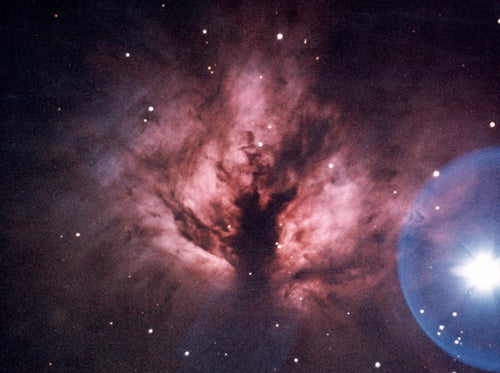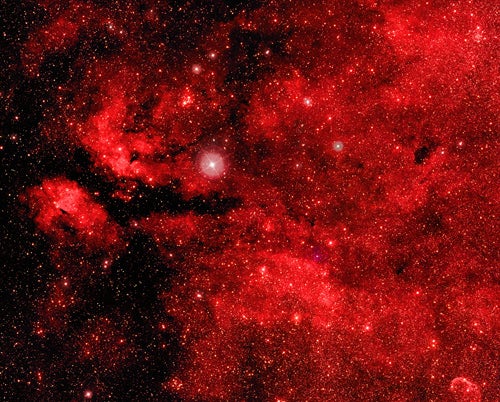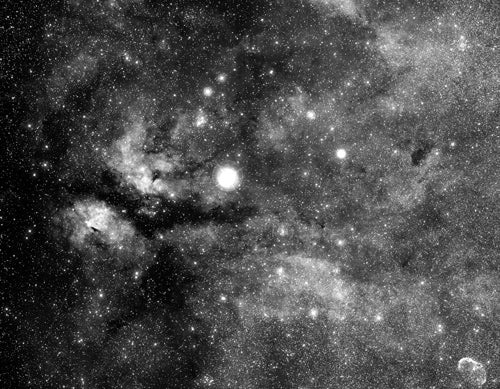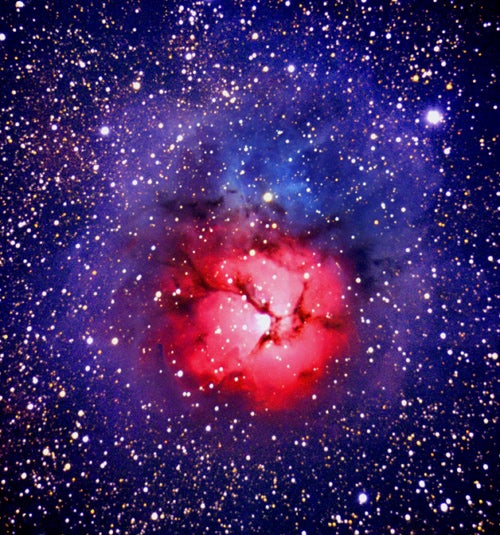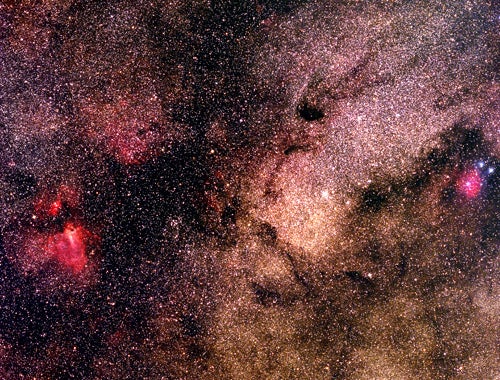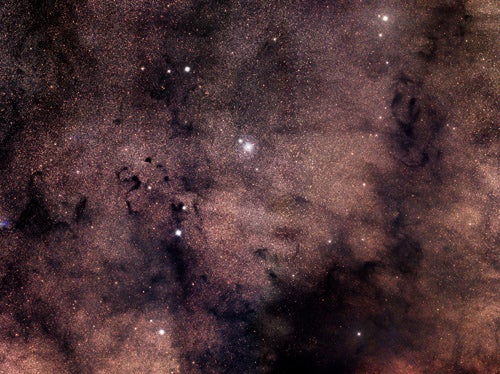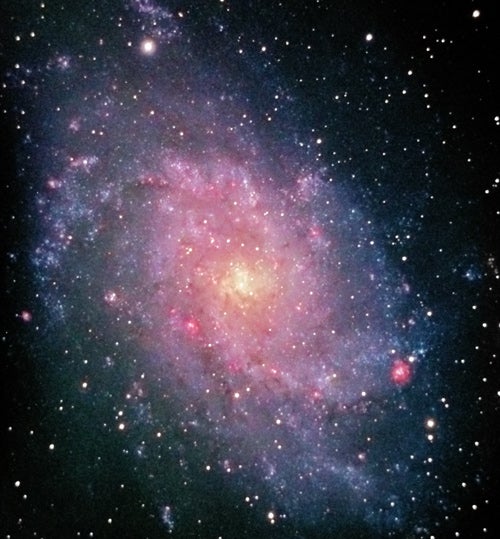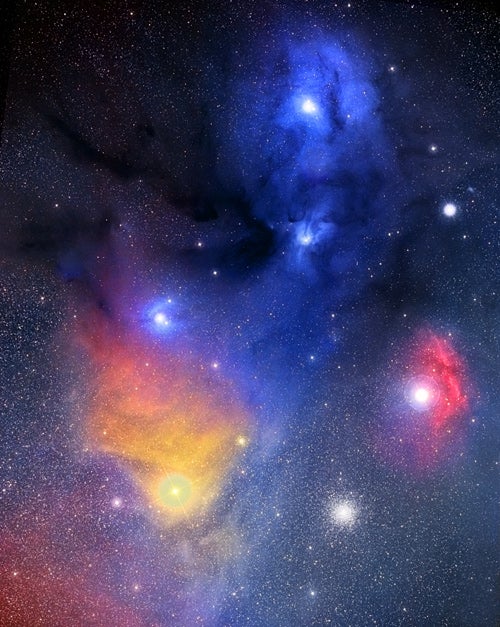Astrophotographer Jason Ware is not the last of a dying breed, but he’s close. Ware takes images of celestial objects on film, and that’s a rarity in this day of digital technology and the recent proliferation of digital SLRs. But Ware uses digital image-enhancement techniques to improve his film photographs. His story, “Sharper photos with film,” details some of his methods. What follows are some of his superb images we couldn’t fit into the magazine. Enjoy!
The Flame Nebula
The Flame Nebula (NGC 2024) in Orion is a difficult object to observe due to the closeness of the bright star Alnitak (Zeta [z] Orionis). Ware made two 60-minute exposures on Fuji HG 400 film through his 16-inch Meade LX200 Schmidt-Cassegrain telescope at f/10.
The Flame Nebula (NGC 2024) in Orion is a difficult object to observe due to the closeness of the bright star Alnitak (Zeta [z] Orionis). Ware made two 60-minute exposures on Fuji HG 400 film through his 16-inch Meade LX200 Schmidt-Cassegrain telescope at f/10.
Gamma Cygni
The region of Gamma Cygni is alive with activity. Ware created this image with his 12/16-inch Meade Schmidt camera at f/2.2. He took two 30-minute exposures on Kodak Technical Pan film through a #92 red filter and two 15-minute exposures on Fuji 100 color print film.
The region of Gamma Cygni is alive with activity. Ware created this image with his 12/16-inch Meade Schmidt camera at f/2.2. He took two 30-minute exposures on Kodak Technical Pan film through a #92 red filter and two 15-minute exposures on Fuji 100 color print film.
Gamma Cygni
In black and white, the same region around Gamma Cygni as in the previous photo shows subtle differences from the color version. Ware created this image using only the two 30-minute exposures (on Kodak Technical Pan film through a #92 red filter) taken for the previous image.
In black and white, the same region around Gamma Cygni as in the previous photo shows subtle differences from the color version. Ware created this image using only the two 30-minute exposures (on Kodak Technical Pan film through a #92 red filter) taken for the previous image.
The Trifid Nebula (M20) in Sagittarius is a showpiece object when you observe it under a dark sky. Ware used his 16-inch Meade LX200 Schmidt-Cassegrain telescope at f/10. To produce the final image, he combined two 30-minute exposures on Kodak Technical Pan film through a #92 red filter with two 15-minute exposures on Fuji 100 color print film.
Jason Ware
The Trifid Nebula
The Trifid Nebula (M20) in Sagittarius is a showpiece object when you observe it under a dark sky. Ware used his 16-inch Meade LX200 Schmidt-Cassegrain telescope at f/10. To produce the final image, he combined two 30-minute exposures on Kodak Technical Pan film through a #92 red filter with two 15-minute exposures on Fuji 100 color print film.
The Trifid Nebula (M20) in Sagittarius is a showpiece object when you observe it under a dark sky. Ware used his 16-inch Meade LX200 Schmidt-Cassegrain telescope at f/10. To produce the final image, he combined two 30-minute exposures on Kodak Technical Pan film through a #92 red filter with two 15-minute exposures on Fuji 100 color print film.
M24
M24 is a rich area of the Milky Way in Sagittarius. To create this image, Ware made two 15-minute exposures on Fuji 100 color print film through his 12/16-inch Meade Schmidt camera at f/2.2.
M24 is a rich area of the Milky Way in Sagittarius. To create this image, Ware made two 15-minute exposures on Fuji 100 color print film through his 12/16-inch Meade Schmidt camera at f/2.2.
The Snake Nebula
The Snake Nebula (Barnard 72) in Ophiuchus is an interstellar cloud made of dust and cold gas. Ware took two 30-minute exposures on Kodak PPF 400 print film using his 16-inch Meade Schmidt-Cassegrain telescope at f/10.
The Snake Nebula (Barnard 72) in Ophiuchus is an interstellar cloud made of dust and cold gas. Ware took two 30-minute exposures on Kodak PPF 400 print film using his 16-inch Meade Schmidt-Cassegrain telescope at f/10.
The Pinwheel Galaxy
The Pinwheel Galaxy (M33) in Triangulum is a member of our Local Group. Ware used his 8-inch Meade LX6 at f/10 to create this image. He took 90- and 180-minute exposures on Kodak Technical Pan film and two 60-minute exposures on Fuji HG 400 color film.
The Pinwheel Galaxy (M33) in Triangulum is a member of our Local Group. Ware used his 8-inch Meade LX6 at f/10 to create this image. He took 90- and 180-minute exposures on Kodak Technical Pan film and two 60-minute exposures on Fuji HG 400 color film.
Rho Ophiuchi
The Rho Ophiuchi complex offers one of the sky’s most colorful regions. To image this large area, Ware used his 12/16-inch Meade Schmidt camera at f/2.2. He took two 10-minute exposures on Kodak Technical Pan film and two 15-minute exposures on Fuji 100 print film.
The Rho Ophiuchi complex offers one of the sky’s most colorful regions. To image this large area, Ware used his 12/16-inch Meade Schmidt camera at f/2.2. He took two 10-minute exposures on Kodak Technical Pan film and two 15-minute exposures on Fuji 100 print film.

